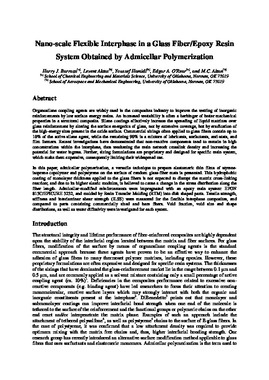| dc.contributor.author | Barraza, H. J. | |
| dc.contributor.author | Aktas, L. | |
| dc.contributor.author | Hamidi, Y. K. | |
| dc.contributor.author | O'Rear, E. A. | |
| dc.contributor.author | Altan, M. C. | |
| dc.date.accessioned | 2016-03-23T19:53:22Z | |
| dc.date.accessioned | 2016-03-30T15:35:40Z | |
| dc.date.available | 2016-03-23T19:53:22Z | |
| dc.date.available | 2016-03-30T15:35:40Z | |
| dc.date.issued | 2002 | |
| dc.identifier.citation | Barraza, H. J., Aktas, L, Hamidi, Y., O'Rear, E. A. and Altan, M. C. Nano-scale Flexible Interphase in a Glass Fiber/Epoxy Resin System Obtained by Admicellar Polymerization, Presented at the 18th International Conference of the Polymer Processing Society. Article # 400, 2002. | en_US |
| dc.identifier.uri | https://hdl.handle.net/11244/33175 | |
| dc.description.abstract | Organosilane coupling agents are widely used in the composites industry to improve the wetting of inorganic reinforcements by low surface energy resins. An increased wettability is often a harbinger of better mechanical properties in a structural composite. Silane coatings effectively increase the spreading of liquid matrixes over glass reinforcement by altering the surface energetics of glass, not by extensive coverage, but by eradication of the high-energy sites present in the oxide surface. Commercial sizings often applied to glass fibers contain up to 10% of the active silane agent, while the remaining 90% is a mixture of lubricants, surfactants, anti-stats, and film formers. Recent investigations have demonstrated that non-reactive components tend to remain in high concentrations within the interphase, thus weakening the resin network crosslink density and increasing the potential for water ingress. Further, sizing formulations are proprietary and designed for specific resin system, which make them expensive, consequently limiting their widespread use.
In this paper, admicellar polymerization, a versatile technique to prepare elastomeric thin films of styrene-isoprene copolymer and polystyrene on the surface of random glass-fiber mats is presented. This hydrophobic coating of monolayer thickness applied to the glass fibers is not expected to disrupt the matrix cross-linking reaction; and due to its higher elastic modulus, is believed to cause a change in the stress distribution along the fiber length. Admicellar-modified reinforcements were impregnated with an epoxy resin system: EPON 815C/EPICURE 3232, and molded by Resin Transfer Molding (RTM) into disk shaped parts. Tensile strength, stiffness and interlaminar shear strength (ILSS) were measured for the flexible interphase composites, and compared to parts containing commercially sized and bare fibers. Void fraction, void size and shape distributions, as well as water diffusivity were investigated for each system. | en_US |
| dc.subject | Engineering, Chemical., Composite Materials | en_US |
| dc.title | Nano-scale Flexible Interphase in a Glass Fiber/Epoxy Resin System Obtained by Admicellar Polymerization | en_US |
| dc.type | Other | en_US |
| dc.description.peerreview | Yes | en_US |
| dc.description.peerreviewnotes | Peer reviewed and presented at the 18th International Conference of the Polymer processing Society. | en_US |
| ou.group | College of Engineering::School of Chemical, Biological and Materials Engineering | en_US |
